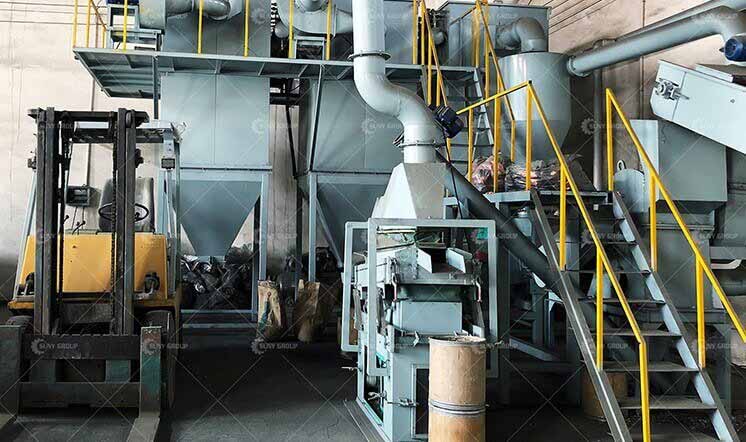At present, it is an opportunity for the rapid development of the waste battery recycling industry. The cobalt, lithium, copper and plastics in the waste lithium battery are precious resources and have high recycling value. Therefore, scientific and effective treatment of waste lithium batteries not only has significant environmental benefits, but also has good economic benefits. Lithium batteries are mainly composed of a casing, a positive electrode, a negative electrode, an electrolyte and a separator. The positive electrode is constructed by coating lithium cobalt oxide powder on both sides of the aluminum foil current collector through PVDF which has a binding effect; the negative electrode structure is similar to the positive electrode, and is composed of carbon powder bonded on both sides of the copper foil current collector. The effective separation of the negative electrode constituent materials of the waste lithium battery has a driving effect on maximizing the resource utilization of the waste lithium battery and eliminating its corresponding environmental impact. Commonly used waste lithium battery recycling methods include hydrometallurgy, pyrometallurgy and mechanical physical method. Compared with the wet method and the fire method, the mechanical physical method does not require the use of chemical reagents and has lower energy consumption. It is an environmentally friendly and efficient method. The anode and cathode structure of lithium battery produced by Shibang Machinery and the material characteristics of its constituent materials, copper and carbon powder, are separated and recycled using a combined process of hammer crushing, vibrating screening and airflow sorting.

Features of lithium battery recycling equipment:
1. The combined process of hammer crushing, vibrating screening and airflow sorting can realize the resource utilization of metal copper and carbon powder in the anode material of waste lithium batteries;
2. The negative electrode material can be effectively separated from the carbon powder and the copper foil through the hammer vibration, and then the copper foil and the carbon powder can be separated by the vibration sieve based on the difference in size and shape between particles. The results of hammer vibration peeling and sieving separation show that copper and carbon powder are respectively enriched in the particle size range of particle size greater than 0.250 mm and particle size less than 0.125 mm, with grades as high as 92.4% and 96.6% respectively, and can be directly sent to downstream enterprises for recycling use;
3. For crushed particles with a particle size of 0.125~0.250 mm and a low copper grade, airflow sorting can be used to achieve effective separation between copper and carbon powder. When the airflow velocity is 1.00 m/s, a good recovery effect can be achieved , The recovery rate of metallic copper can reach 92.3%, and the grade can reach 84.4%;
4. This equipment is mainly used by lithium ion battery manufacturers to separate aluminum and copper from the anode and cathode materials in the scrapped anode and cathode sheets for recycling purposes. The complete set of equipment is operated under negative pressure, no dust is discharged, and the separation efficiency can reach more than 98%.
Thank you for your interest in suny group. If you want to learn more about our E-waste recycling plant, copper wire recycling machine and other machines, Contact us now to find out what we can do for you next project!E-mail:sunymachine@gmail.com | Whatsapp:+8613674945231